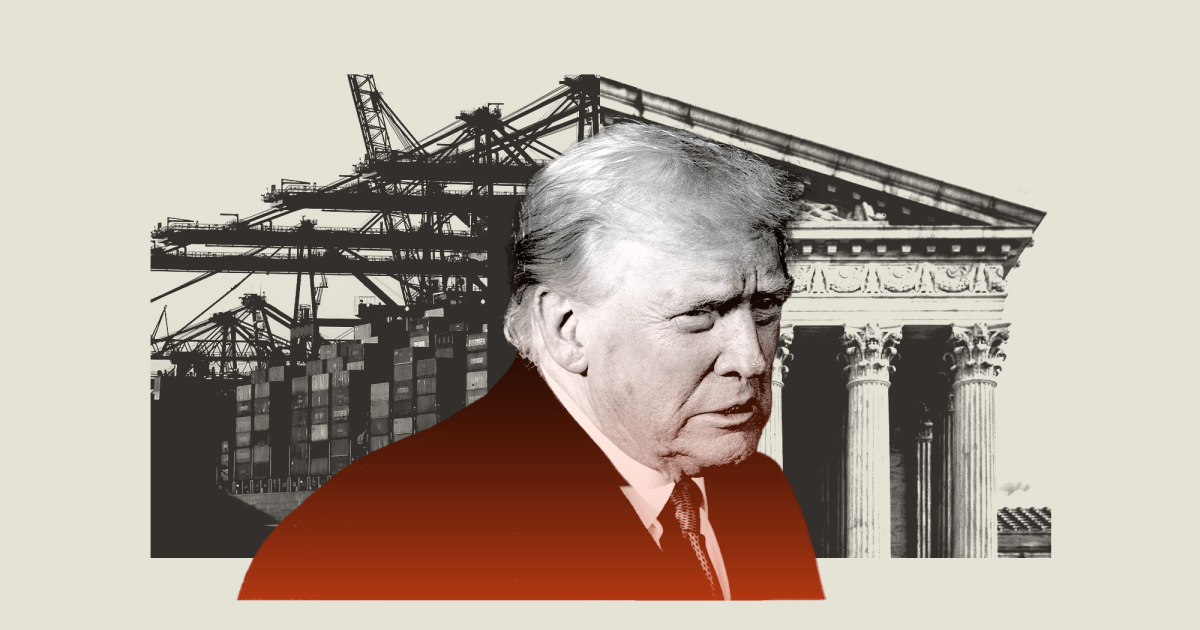On Wednesday, the Supreme Court will hear oral arguments over President Donald Trump’s decision to impose tariffs on almost every nation on earth, in ever-changing amounts, whenever he feels like it. Legally, this is a case about any number of complicated questions and legal doctrines, including the president’s ability to declare emergencies under the International Economic Emergency Powers Act, the court’s novel major questions doctrine, its dormant non-delegation doctrine, the proper venue for challenging the tariffs, and the proper statutory interpretation of IEEPA.
“This is not just a battle over tariffs.” It’s a battle over just who is in charge of the GOP.
But these questions will almost certainly be window-dressing on a decision driven by how Chief Justice John Roberts and the other five Republican appointees navigate between the two stakeholders in this case: the powerful billionaires and business interests behind the challenge to the tariffs and Trump’s desire to transform the economy into an arm of his personalist rule.
“This is not just a battle over tariffs,” explains Evan Bernick of the Northern Illinois University College of Law. “It is a battle between competing political economies within the American right. And how it works out will speak to just who ultimately has hegemony, who… is shaping the law of the United States.” While Bernick expects the businesses and states challenging the tariffs to prevail, “if they do not,” he says, “that tells me things about the relative power of these competing factions that I did not previously know.”
In February and again in April, Trump cited IEEPA when imposing his sweeping—and sometimes very high—tariffs, some of which he went on to pause. While the Constitution grants Congress the power to impose tariffs, Trump claimed his actions were a legitimate use of that 1977 law, which gives presidents power to respond to “any unusual and extraordinary threat” from abroad, even though IEEPA doesn’t specifically name tariffs as an available tool. The court is hearing two consolidated cases brought by multiple small businesses. Some of the companies’ challenges were brought with support from ideologically conservative and libertarian nonprofits funded by wealthy Republican-allied donors, most notably the Koch network.
For decades, the Kochs and their fellow-traveling tycoons, along with the religious right, channeled millions of dollars into a project to capture the Supreme Court, successfully creating a loyal 6-3 conservative majority. Beginning in 2005 with Roberts’ nomination, the Federalist Society vetted Republican nominees and their allies helped win their confirmations with lots of money. As Lisa Graves, who leads the judicial watchdog group True North Research and has published a new book on Roberts, recently told me, “Roberts is really the beneficiary of the first billionaire-backed campaign to capture the US Supreme Court.” He’s spent the last 20 years implementing their agenda.
The Roberts Court consistently rules for the interests of this small set of billionaire political donors, whose money flowed to the Federalist Society and other activist groups that helped each of the Republican-appointed justices reach the high court. Further, under Roberts, these members of the court have increased the political power of the GOP and its wealthiest patrons. For example, the court has been dismantling the Voting Rights Act to the benefit of the GOP, a project they will likely finish in the next few months. It has also cut the power of labor unions, and, by overturning the long-held practice of courts deferring to agency expertise, declared open season on federal regulations that industry dislikes. In its stead, the justices invented the major questions doctrine to justify striking down executive regulations the court decides are “major” and that don’t have clear authorization from Congress, and created increasingly radical interpretations of the unitary executive theory that have weakened agency independence so that partisan politics can destroy industry regulation.
This clear preference for moneyed interests was detailed by employment lawyer Scott Budow in a 2021 law review article on how the Roberts Court has changed labor and employment law. He discussed 15 cases in which the justices cast a collective 134 votes. “There is no unifying judicial philosophy—such as originalism or textualism—that neatly explains why conservative justices would reliably vote in one manner and liberal justices in the opposite manner for these cases,” he concluded. “Yet, if all one knew was that conservative justices favor employers and liberal justices favor workers, that person would have correctly predicted 132 of the 134 votes cast.” That is 98.5 percent of the time.
“Trying to interpret or anticipate what’s going to happen in cases involving Trump inside the four corners of legal reasoning will fail, and hasn’t really explained almost anything the Robert’s court [has done] for the last 20 years,” says Michael Podhorzer, the former political director of the AFL-CIO. “Instead, if you step back and think about the interests that elevated the six of them to the court, then that is really very clarifying.”
This case has big business going up against the president.
In their 2022 book The Scheme: How the Right Wing Used Dark Money to Capture the Supreme Court, Sen. Sheldon Whitehouse (D-R.I.) and attorney Jennifer Mueller breakdown not only the story of how a small handful of rightwing families and groups channeled millions to put allies on the court, but how they also fund an array of legal outfits to bring cases and file amicus briefs—filings that help to signal to the justices which way their benefactors hope they will rule. As Whitehouse and Mueller write, between 2014 and 2020, 16 rightwing foundations gave nearly $69 million to 11 groups that filed amicus curiae briefs urging the court to hobble the Consumer Financial Protection Bureau, which guards against predatory financial industry practices, as well as more than $33 million to the Federalist Society. These groups include the Washington Legal Fund, the Pacific Legal Foundation, the New Civil Liberties Alliance, and the Liberty Justice Center—all of which have used Koch money to challenge labor unions and weaken government regulations. Repeatedly, the GOP wing of the court has handed these organizations, and their donors, major victories.
Those same four legal groups that worked so hard to disempower unions and destroy the regulatory state are now before the court with a new request: stop Trump’s arbitrary tariffs. They have a strong case, at least under the Roberts court’s precedents—after all, the justices have created a brand new doctrine, the major questions doctrine, and used it to strike down regulations without clear statutory authorization that industry doesn’t like. Tariffs on nearly every nation are by every measure “major” actions that can make or break businesses and reshape both the US and world economies.
But unlike in other major questions doctrine cases, when industry was pitted against Democratic priorities like environmental regulations or student debt relief programs that the six conservative justices struck down, this case has the business community going up against the president.
Trump, too, has been on a winning streak before the six GOP justices, who have repeatedly used their emergency or shadow docket to greenlight the president’s agenda, from slashing the federal bureaucracy to detaining suspected immigrants based on the color of their skin. As of last month, Trump had won some 21 emergency appeals to the court. The Republican wing even restricted lower courts’ authority to grant relief from Trump’s policies. The logical conclusion is that the justices are either on board with Trump’s authoritarian project, protective of his political coalition, or possibly also afraid to cross him for fear he disobeys their orders. Perhaps it is a combination of these factors, but the result is a court that contorts itself—or remains completely silent—in order to repeatedly rule in Trump’s favor. As Justice Ketanji Brown Jackson wrote in a dissent in August, analogizing her colleagues jurisprudence to a make-believe game from Calvin and Hobbes: “Calvinball has only one rule: There are no fixed rules. We seem to have two: that one, and this Administration always wins.”
But this time, the administration is up against the court’s other preferred client, and one of their winning streaks must come to an end. One view of what’s coming starts with the solid premise that while ultrawealthy business interests don’t agree with all of Trump’s agenda, they prefer him to a Democrat. If we presume that Roberts and the court’s other Federalist Society recruits similarly view Trump as an essential—even if often misguided—element of their project, then they will try to limit his tariffs without strongly rebuking him. “I think the calculus that they’re going through is basically, ‘Would trying to stop him there lead to electoral defeat, or not? Is it too damaging to them?’” says Podhorzer, who also expects the court “at a minimum” will “do something that trims or constrains” Trump’s claimed tariff powers.
“It’s important to look at whatever they end up doing as a reflection of where that business community is right now,” he adds. A decisive victory for Trump might signal that big business will tolerate a tariff regime in which they write multi-million dollar checks to Trump’s ballroom project in exchange for waivers—although they don’t seem to be there yet because, after all, they did help bring this challenge in the first place. A big Trump win could also signal that the justices themselves sense a fundamental shift in where power lies on the right, from the moneyed interests that created the court to the openly authoritarian MAGA movement.
Legally, there are a lot of ways the justices could resolve this case. But it will be more illuminating to think of the Republican wing not as judges weighing arguments but as mediators seeking a compromise between two competing factions of the same team.














